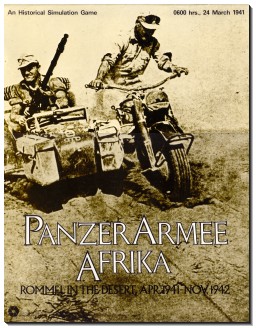
PanzerArmee Afrika, subtitled "Rommel in the Desert, April 1941 - November 1942", is a board wargame published by Simulations Publications, Inc. (SPI) in 1973 that simulates the World War II North African Campaign that pitted the Axis forces commanded by Erwin Rommel against Allied forces. The game was revised and republished in 1984 by Avalon Hill.
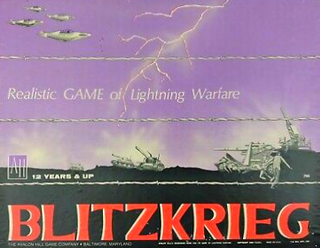
Blitzkrieg is a strategic-level wargame published by Avalon Hill in 1965 that simulates a non-historical attack by one major power against another using the blitzkrieg strategy. It was the first commercial wargame that did not simulate an actual historical battle, and with almost 400 counters, it was a precursor to the "monster" wargames of the 1970s featuring more than a thousand counters.
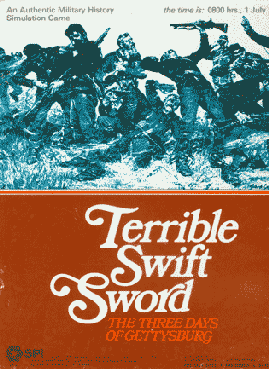
Terrible Swift Sword: Battle of Gettysburg Game is a grand tactical regimental level board wargame published by Simulations Publications, Inc. (SPI) in 1976 that simulates the Battle of Gettysburg during the American Civil War. A second edition was published by TSR in 1986.

Conquistador, originally subtitled "The Age of Exploration: 1495–1600", is a board game published by Simulations Publications, Inc. (SPI) in 1976 that simulates the exploration of the New World in the 16th century. Players take on the role of European countries sending expeditions to find gold and establish colonies. Although the design uses the trappings of board wargames such as a hex map, combat is not a major part of the game.

NATO: Operational Combat in Europe in the 1970s is a board wargame published by Simulations Publications Inc. (SPI) in 1973 that simulates an invasion of Western Europe by the Warsaw Pact.
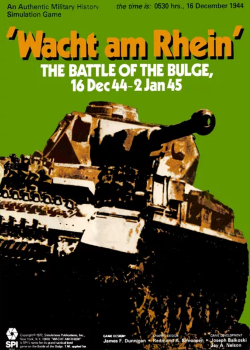
Wacht am Rhein is a grand tactical monster board wargame published by Simulations Publications, Inc. (SPI) in 1977 that simulates Germany's Battle of the Bulge offensive in late 1944 during World War II.

Schutztruppe, subtitled "East African Guerilla Warfare, 1914-1918", is a board wargame originally self-published by Jim Bumpas in 1975, then published by Flying Buffalo in 1978, that simulates the conflict between German Schutztruppe and Allied forces during World War I.

The Battle of Borodino: Napoleon in Russia 1812 is a board wargame published by Simulations Publications Inc. (SPI) in 1972 that is a simulation of the Battle of Borodino during the French invasion of Russia in 1812.

Fulda Gap, subtitled "The First Battle of the Next War", is a board wargame published by Simulations Publications Inc. (SPI) in 1977 that simulates a hypothetical attack by Warsaw Pact forces against NATO defenders in West Germany using technology and tactics of the mid-1970s

Lee Moves North, originally titled Lee at Gettysburg and subtitled "The Confederate Summer Offensive, 1862 & 1863", is a board wargame published by Simulations Publications Inc. (SPI) in 1972 that simulates Robert E. Lee's summer offenses of 1862 and 1863 during the American Civil War

Korea: The Mobile War is a board wargame published by Simulations Publications Inc. (SPI) in 1969 that simulates the Korean War.

MechWar '77, subtitled "Tactical Armored Combat in the 1970s", is a board wargame published by Simulations Publications Inc. (SPI) in 1975 that simulates hypothetical tank combat in the mid-1970s between various adversaries, using the same rules system as the previously published Panzer '44.

The Moscow Campaign, subtitled "Strike and Counterstrike Russia", is a board wargame published by Simulations Publications Inc. (SPI) in 1972 that simulates combat near Moscow during World War II.

Rocroi, subtitled "19 May 1643 – The End of Spanish Ascendancy", is a board wargame published by Simulations Publications Inc. (SPI) in 1976 that simulates the 1643 Battle of Rocroi during the Thirty Years' War. Rocroi was originally sold as one of four separate games packaged together in Thirty Years War, a "quadrigame", but it was also published as an individual game. It received mixed reviews from critics, some of whom called it a "bland tactical problem", while others declared it was the best game of the four in the Thirty Years War box.
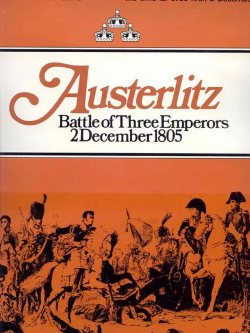
Austerlitz, subtitled "The Battle of Three Emperors, 2 December 1805", is a board wargame published by Simulations Publications Inc. (SPI) in 1972 that simulates the Battle of Austerlitz between Napoleon's French forces, and the Austrian-Russian forces of the Third Coalition.

Mukden: Sino-Soviet Combat in the '70s is a board wargame published by Simulations Publications Inc. (SPI) in 1975 that simulates a contemporary hypothetical battle between Soviet and Chinese forces near the city of Mukden. It was one of four games that were part of the "quadrigame" titled Modern Battles: Four Contemporary Conflicts, but it was also released as an individual game. In a 1976 poll, Mukden was the least popular of the four games in Modern Battles.

Normandy: The Invasion of Europe 1944 is a board wargame published by Simulations Publications Inc. (SPI) in 1969 that simulates the D-Day landings on the beaches of Normandy, and the six days that followed as the German forces tried to prevent an Allied break-out. A second revised edition was published in 1971
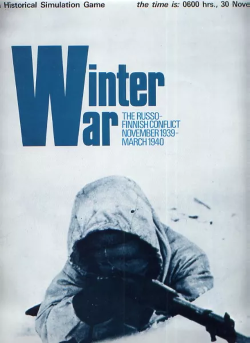
Winter War: The Russo-Finnish Conflict is a board wargame published by Simulations Publications Inc. (SPI) in 1972 that simulates the Soviet Union's 1939 invasion of Finland during World War II.
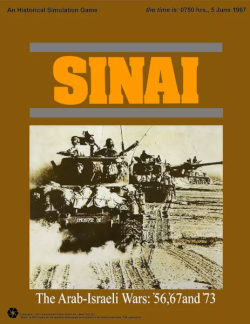
Sinai: The Arab-Israeli Wars – '56, '67 and '73 is a board wargame published by Simulations Publications Inc. (SPI) in 1973 that simulates three conflicts in the Middle East: The 1956 Suez Crisis, the 1967 Six-Day War, and the just-completed 1973 Yom Kippur War. The staff of SPI had been developing a wargame simulating a hypothetical Middle East conflict when war broke out in October 1973. Using newspaper and television reports, SPI found that their envisioned simulation was not accurate, and quickly redeveloped the game, releasing it only weeks after a ceasefire had been signed. The game proved very popular, and remained a best-seller for SPI during the 1970s.

Strike Force One, subtitled "The Cold War Heats Up — 1975", is a board wargame published by Simulations Publications Inc. (SPI) during the Cold War in 1975 that simulates a hypothetical clash in West Germany between Soviet Union invaders, and American defenders. The short and simple game was designed as an introduction to the hobby of wargaming, and was given away as a free promotional item.




















